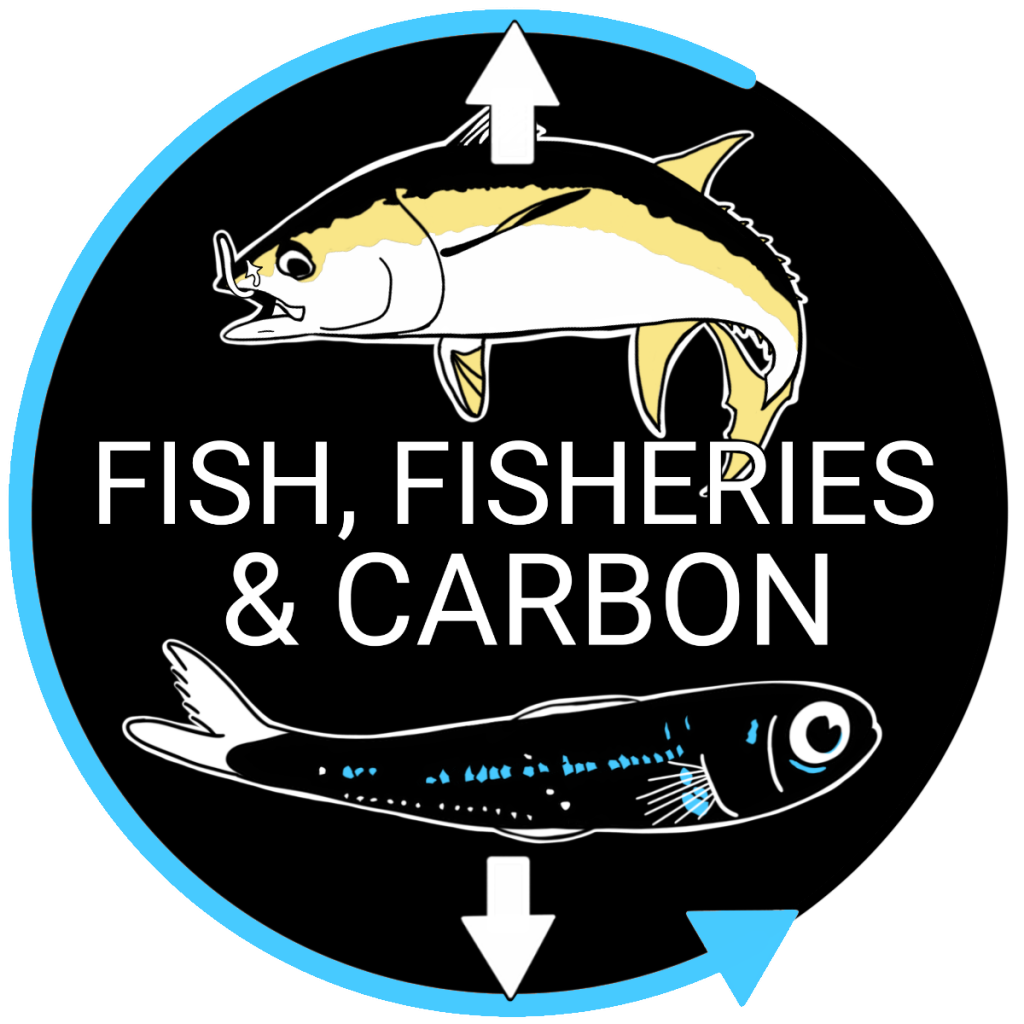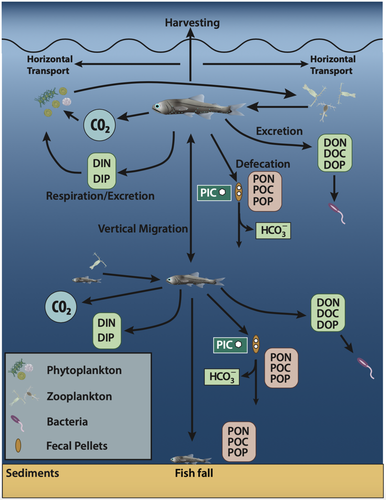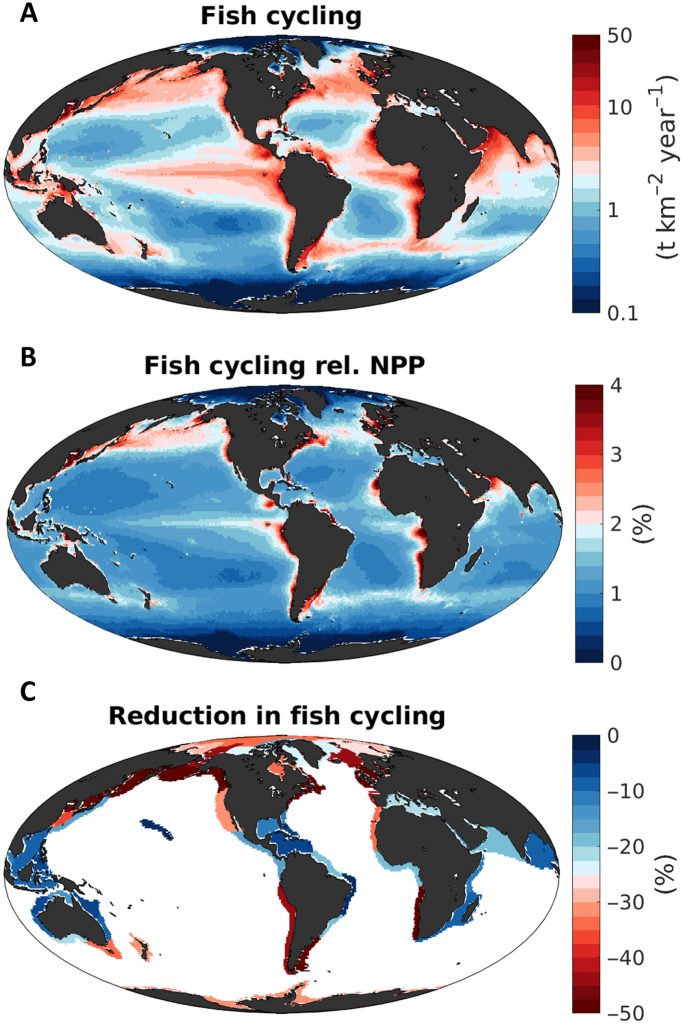Workshop organizing committee
Grace Saba and Lauren Cook (Rutgers University, USA) – Session 1 Chairs
Emma Cavan (Imperial College London, UK) and Simeon Hill (British Antarctic Survey, UK) – Session 2 Chairs
Rebecca Hubbard (Our Fish, Netherlands) and Rashid Sumaila (University of British Columbia, Canada) – Session 3 Chairs
Heather Benway, Mai Maheigan (Ocean Carbon & Biogeochemistry (OCB) Project Office, WHOI, USA)

Plenary speakers
New insights on the role of fishes in ocean carbon flux - Grace Saba
(Rutgers Univ)
Variability of active flux driven by mesopelagic fishes - Santiago Manuel Hernández León (Universidad de Las Palmas de Gran Canaria)
Fish carbonate excretion and mineralogy in coral reef systems - Mattia Ghilardi (Leibniz Centre for Tropical Marine Research)
Ocean biogeochemical fingerprints of fast-sinking fish detritus - Jessica Luo (NOAA/GFDL)
Lightning talks
Lauren Cook - Closing the fish carbon export gap: Laboratory-based approaches in creating a full carbon production suite for an abundant North Atlantic forage fish
Angela Martin - Carbon deposition in faecal material of coastal fishes
Linbin Zhou - A new model for describing carbon released by fish
Konstantina Agiadi - Mesopelagic fish body size under climate warming: insights from the deep time
Andy Visser - Vertical migrants and carbon sequestration
Julek Chawarski - Global patterns in vertical connectivity between the mesopelagic zone and the deep ocean
SESSION 2: Fishery impacts on carbon sinks (Session leaders: Emma Cavan and Simeon Hill)
WHEN: 8 March 2023: 0700 PST, 1000 EST, 1500 UTC (GMT), 0200 9 March AEDT
Plenary speakers
Where we are in fishery-carbon science - Emma Cavan (Imperial College London)
The global biomass and biogeochemical cycling of marine fish with and without fishing - Daniele Bianchi (Univ. California, Los Angeles)
Fishery Emissions in a Blue Carbon Context - Erica Ferrer (Scripps Inst. Oceanography)
Impact of bottom trawling on long-term carbon sequestration in shelf sea sediments - Lucas Porz (Helmholtz-Zentrum Hereon)
Lightning talks
OceanICU: WP on fisheries - Thibault Cariou
A century of fish biomass decline in the ocean - Villy Christensen
Fishing, prey release, productivity and respiration - theory to (future) empirical data - Rick Stafford
Improving Carbon Understanding for a healthy and resilient ocean and sustainable blue economy - Mary Wisz
WHEN: 9 March 2023: 1400 PST, 1700 EST, 2200 UTC (GMT), 0900 10 March AEDT
Plenary Speakers
Why manage fish stocks to protect carbon? - Rashid Sumaila (University of British Columbia)
Fisheries management is carbon management - Rebecca Hubbard (Our Fish)
Governing Open Ocean and Fish Carbon - Maartje Oostdijk (World Maritime Univ., Sweden)
Balancing economic, ecosystem, and carbon goals in fisheries management - Andrew Pershing (Climate Central)
Sustainable fisheries is an important climate solution - William Cheung (UBC)
Lightning Talks
OceanICU: Integrated Carbon Understanding - Debbi Pedreschi
Conservation of fish stocks to mitigate climate change. - Nathalie Hilmi
A new narrative: Our AU tech converts CO2 to ocean fish food. - Phil Kithil
First half (90 minutes)
Welcome (5 minutes)
4 x invited talks from researchers, NGOs and policy makers relevant to the central topic of that session (65 minutes)
5 x lightning talks (3 mins each, 20 mins total)
15 minute Break
Second half (75 minutes)
Break-out interactive discussions to design future research/policy directions (60 mins)
Information shared on next steps, how to interact with the community and close (15 mins)

Fig. 1. Conceptual diagram highlighting the mechanisms by which fishes contribute to the biological carbon pump and nutrient cycling. Arrows between different types of organisms infer predation from a prey item to a predator (arrow pointing to the predator; e.g., zooplankton feeding on phytoplankton in the upper water column, myctophids feeding on zooplankton in the upper water column, myctophid feeding on zooplankton and small fishes in mid-water). From Saba et al. (2021).
SCIENTIFIC BACKGROUND
The biological pump transports carbon to the deep ocean, and our understanding of this process has greatly improved over the last decade, from a traditional view focused exclusively on plankton sinking, to a more holistic view which includes mixed layer pumps, seasonal lipid pumps and the contribution of fish to carbon transport (Boyd et al., 2019). The biological pump is represented in Earth System Models and thus has a role in climate projections. The biological pump can remove carbon from the surface ocean, whilst also recycling carbon and other nutrients throughout the ocean depths, which eventually feeds back to surface ocean productivity. A lack of research on trophic levels beyond plankton means we do not have the data to parameterise higher trophic levels in high resolution, global biogeochemical models. Yet a paper published by the ‘Towards a better understanding of fish contribution to carbon flux’ OCB working group led by Grace Saba (Saba et al., 2021) found that fish contribute 16 % (1.5 Gt C yr-1) to total gravitational carbon sink, via faecal pellets and deep respiration (Fig. 1). Clearly, fish and other trophic levels beyond plankton (e.g. krill, salps, jellyfish) could have important feedbacks on the earth system. But data and thus our understanding of the complex feedbacks and their temporal and spatial variation are sparse.

Fig. 2. Direct and indirect impacts of fishing to the carbon sink. Phytoplankton (green shading in the surface) stimulate fish biomass production and the export of carbon out of the upper ocean, of which ~ 1 % sinks to the deep ocean. The carbon sink is enhanced by fertilising species and those egesting fast-sinking carbon-rich faecal pellets. Direct impacts of fishing (left) include harvesting pellet-producing species, removing species living near the seabed, sediment disturbance from groundfish harvesting, removing mesopelagic species and finally reducing large falls of dead organic matter to the deep sea and sediment. Indirect impacts (right) include causing trophic cascades impacting communities that sink carbon, removing prey items for fertilizing species (e.g. mackerel or krill that feed seabirds), killing predators (e.g. seabirds) that may otherwise fertilise the oceans and help to maintain a balanced food web, and finally the release of discards which could cause localized dead zones. From Cavan & Hill 2022.
In addition to environmentally driven changes in the distribution, abundance, and diversity of higher level organisms, industrial fishing and whaling have been changing the composition of marine ecosystems for decades and causing the collapse of some fish stocks. Much of the research on fishing impacts focuses on the harvested species themselves, although trophic cascades caused by fishing can affect the entire foodweb, including plankton (Fig. 2). This means fishing is likely to impact the carbon sink by causing 1) changes to the plankton gravitational sink, and 2) a loss of sinking carbon from harvested fish (Cavan and Hill, 2022). The loss of sinking fish carcasses due to harvesting and the CO2 emitted by fishing vessels alone has released 0.73 Gt CO2 since the 1950s (Mariani et al., 2020), whilst industrial exploitation of fish stocks is thought to have halved fish biogeochemical cycling with impacts on primary production and the carbon sink (Bianchi et al., 2021) (Fig. 3). Given our lack of knowledge on the fish contribution to the carbon sink as described above and the complexity in predicting trophic cascades, quantifying the total potential consequence of industrial fishing on the biological pump is not trivial. Nonetheless progress has been made on understanding the contribution of a non-fished group, the mesopelagic fish to the carbon sink.

Fig. 3. Reduction (%) of the biomass cycling rate by targeted fish at the time of the global peak catch, averaged over Large Marine Ecosystems (Bianchi et al. 2021)
Ideally if we are able to quantify how fishing changes the biological pump, and come up with monitoring solutions to keep track of fishing impacts, then the protection of the biological pump could be implemented into fisheries policy. This is a delicate task though, as aquatic food sources could be key in ending world hunger (Golden et al., 2021), and there are a myriad of social and economical factors to consider as fishing supports the livelihoods of millions of people worldwide. The integrative topic of fish, fisheries, and carbon has been gaining wide interest quite rapidly over the past few years, but the diverse range of experts have not yet convened to comprehensively discuss and address the effect of fishing on potential carbon sequestration, policy considerations, and potential socioeconomic repercussions.
References
Bianchi, D., Carozza, D., Galbraith, E., Guiet, J., and DeVries, T. 2021. Estimating global biomass and biogeochemical cycling of marine fish with and without fishing. Science Advances, 7: eabd7554. American Association for the Advancement of Science. https://doi.org/10.1126/sciadv.abd7554.
Boyd, P. W., Claustre, H., Levy, M., Siegel, D. A., and Weber, T. 2019. Multi-faceted particle pumps drive carbon sequestration in the ocean. Nature, 568: 327–335. https://doi.org/10.1038/s41586-019-1098-2.
Cavan, E. L., and Hill, S. L. (n.d.). Commercial fishery disturbance of the global ocean biological carbon sink. Global Change Biology, In review.
Golden, C. D., Koehn, J. Z., Shepon, A., Passarelli, S., Free, C. M., Viana, D. F., Matthey, H., et al. 2021. Aquatic foods to nourish nations. Nature. https://doi.org/10.1038/s41586-021-03917-1.
Mariani, G., Cheung, W. W. L., Lyet, A., Sala, E., Mayorga, J., Velez, L., Gaines, S. D., et al. 2020. Let more big fish sink: Fisheries prevent blue carbon sequestration—half in unprofitable areas. Science Advances, 6: eabb4848. http://advances.sciencemag.org/content/6/44/eabb4848.abstract.
Saba, G. K., Burd, A. B., Dunne, J. P., Hernández-León, S., Martin, A. H., Rose, K. A., Salisbury, J., et al. 2021. Toward a better understanding of fish-based contribution to ocean carbon flux. Limnology and Oceanography, n/a. John Wiley & Sons, Ltd. https://doi.org/10.1002/lno.11709.
ORGANIZERS